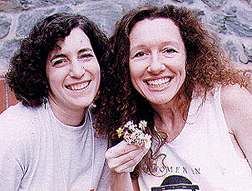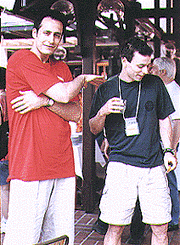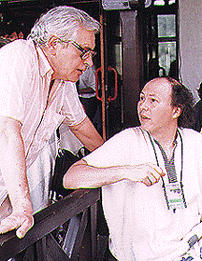The 12th World Festival of Animated Films was held June 10-14, 1996 in Zagreb, where artists, journalists and lovers of animation from around the world gathered to watch more than 50 films representing the best in international animation. Although it is only one in a growing number of important international animation events, Zagreb is unique among festivals for several reasons. Most importantly, it represents not only the proud heritage of Croatia's famed Zagreb School of animation, but also a significant political and cultural institution for the emerging democratic Croatian society....
The 12th World Festival of Animated Films was held June 10-14, 1996 in Zagreb, where artists, journalists and lovers of animation from around the world gathered to watch more than 50 films representing the best in international animation. Although it is only one in a growing number of important international animation events, Zagreb is unique among festivals for several reasons. Most importantly, it represents not only the proud heritage of Croatia's famed Zagreb School of animation, but also a significant political and cultural institution for the emerging democratic Croatian society. Indeed, one finds that in Croatia, the celebration of animation is accorded a degree of respect that is found in few, if any, other countries.
Although the news media tends to focus on the unrest experienced in Croatia and its neighboring countries of the former Yugoslavia, the look and feel of Zagreb--from a visitor's viewpoint, at least--is far from turbulent. The political situation there may be far from settled, but the festival planners, Josko Marusic, Margit-Buba Antauer and Iva Stipetic, did a great job in presenting their guests with the many natural beauties and local entertainments found in Zagreb and its vicinity. Though certainly one does not wish to forget the difficulties that Croatia is now experiencing, it is wonderful to be able to appreciate the many good things the city has to offer.Throughout the five days of the festival, there were opportunities to see many different aspects of Zagreb. Many events were held on the outskirts of the city, at Lisinski Hall, which housed the screenings, many of the related art exhibitions, and Internet facilities connecting the festival to other cities in Croatia and throughout the world. Parties were held in the center of town, at the Euro-disco After Eight Club and at a site near the National Theater. This year's picnic was held at a lovely site on Medvednica Mountain. Many festival-goers chose to eat in the oldest part of the city, with architecture dating from the 11th century. The narrow streets in that section of town are lined with rows of café tables, where evening guests linger, drinking coffee, wine, and beer, speaking various languages (though English always seemed to be welcome), creating the kind of atmosphere that truly can only be found in Europe. Posters in the street announce Zagreb's many cultural events, ranging from gallery openings to dance performances and a range of musical events, from classical to underground. Prices for food and beverages are reasonable by American standards, so a night of dining in the old town turned out to be affordable as well as fun. My first night in the city, I walked through this section of town for some time, trying to counteract the effects of a long plane ride and a 10 hour time difference. Many attractive young women were poised at tables and apparently eager to flirt with my two male companions, who shall remain nameless as they both have girlfriends.

At times, the atmosphere of the festival was decidedly more business-like. On more than one occasion, government dignitaries welcomed festival guests with receptions and small-group meetings. Certainly, the biggest event of this type was one involving Croatian President, Franjo Tudjman, Program Director Josko Marusi, and several attendees. Canada's Ambassador invited Canadian festivalgoers to dine with him, including Chris Robinson (Director of the Ottawa Festival), Caroline Leaf (recipient of the festival's Lifetime Achievement Award) and animator Janet Perlman. All festival guests were invited to the residence of the city's mayor, a gesture that served to underscore the importance of animation as an aspect of Zagreb's cultural heritage. The festival is viewed as being important in part because of its role in bringing an international spotlight on the city.
For me, the diplomatic components of the festival are among the most interesting. A discussion of politics was never far from the surface of things. In most cases, it seemed that everyone felt relatively free to voice their discontent with the slowness of change and, overall, I sensed less optimism than I felt two years ago on my first visit to Zagreb. Another change I sensed was an increasing American presence in the city itself, which I viewed with some disdain. Store windows carried an unsettling amount of Disney merchandise and the golden arches of MacDonald's could be seen plastered on posters throughout the city.
Fortunately, the festival still retains a strong sense of tradition in its programming and entertainment. For almost 75 years, animation has been produced in Croatia, with its famed Zagreb Film studio (started as Duga Film) celebrating its 40th anniversary this year. A special program, "40 Years of the Zagreb Film Animation Studio," spotlighted films made for children. Included were films from the Professor Baltazar series, as well as a number of other short works by Zlatko Grgic, Boris Kolar, Ante Zaninovic, Dragutin Vunak, and Borivoj Povnikovic. Two Zagreb animators were honored with gallery showings of their artwork in various media: Vunak's exhibition focused primarily on works of the past 3 years, while the professional opus of work by Dovnikovic, better known as Bordo, was presented in a showing of his illustrations, comics, and graphic designs from the past 46 years. A retrospective of Macedonian films included 13 short works produced between 1971 and 1989.
Special Programs
Along with more local production, the animations of other countries also were featured in special programs. Five programs of British productions, curated by Pat Raine Webb, covered works from throughout its animation history, while recent American work was the focus of Warner Bros., MTV, Hanna-Barbera and Disney programs. A more marginalized group of artists were featured in a four-day program, "Articulated Light: The Emergence of Abstract Film in America."
Among the other highlights was the presentation of the Life Achievement Award to Caroline Leaf, who is best known for her sand, oil on glass, and scratched animation created during her 20 years at the National Film Board of Canada and elsewhere. Australian film scholar and artist Erik Roberts organized a retrospective screening of Leaf's films, including The Owl Who Married a Goose (1974), The Street (1976), Interview (1979), A Dog's Tale (1986), and Entre Deux Soeurs (Two Sisters, 1990). Later in the week, Leaf and a small group of festival attendees gathered for an informal chat as part of a series entitled "Conversations with the Masters," a regular event at Zagreb that allows 10 to 15 people to get better acquainted with an honored artist. As a special tribute to Leaf, several artists collaborated on a short film entitled Leave a Normal Life, which made its debut at the festival. The film includes visual and aural segments created by Janet Perlman, Derek Lamb, George Griffin and Leaf's other close friends, and features a soundtrack by Peter Gabriel.Online & Other Judging Several programs were dedicated to new technologies and their role in the realm of animation. Playing a major role in the festival was the Croatian Academic and Research Network (CARNet), which used the latest technologies to provide access to the festival to World Wide Web users across the planet. I find it fascinating to see how Croatia has embraced the Internet to create a stronger international presence for itself. At one time, the government provided Internet access to its citizens free of charge and many thousands of people made use of public facilities. Now commercial providers have begun service within the country, which changed the nature of the Internet access. Nonetheless, thousands of Croatians and other individuals were able to get detailed information about the festival. By accessing the Zagreb Festival's home page, a viewer could see brief clips of all the films in competition and vote for his or her favorite work. The winner of the Internet competition was Nick Park's A Close Shave (1995). You can see the Zagreb festival's home page at http://www.awn.com or http://animafest.hr.

Because I will be serving on my first selection committee (for the Ottawa Festival) in a couple of weeks, I was particularly interested in the dynamics of the competition. The Zagreb Festival's selection committee included Gunnar Strøm of Norway, Jill McGreal of the United Kingdom and Ivan Ladislav Galeta of Croatia. The committee selected more than 50 films from 472 submissions and, it seems, there was generally consensus on what works made it into the competition. When questioned about one or two films, committee members did indicate that political reasons necessitated the inclusion of works that otherwise might not have been chosen. With these exceptions, the quality of work submitted was of the same general standard that one sees at most festivals. I often hear the comment that there has not been a real stand-out lately, though Priit Pärn and Janno Poldma's 1895, which won the Grand Prize, seems to have been generally viewed as most worthy of the honor. The Public Prize went to American John Dilworth's crowd-pleaser, Dirdy Birdy (1994) (his Chicken from Outer Space, which got an Oscar nomination earlier this year, and was included in the festival's Hanna-Barbera "What a Cartoon!" screening).
The festival jury was quite well rounded, including Derek Lamb, who has worked extensively in Canada, the United States and Europe, Erik Roberts of Australia, Dragutin Vanuk of Croatia, Marjut Rimminen of Finland, who is working in London, and Bretislav Pojar of Czechoslovakia, who has worked internationally. I was pleased that the festival added a category for abstract films, which generally cannot compete with narrative films for recognition. Austrian Barbel Neubauer, who lives in Germany, won first prize in the category for her film, Roots (1995), for which she created images directly on film and an original score. Killian Dellers of Switzerland and Clive Walley of Wales shared second prize for their films, Vision (1995) and Divertimento No. 5 -- Slapstick (1994), respectively.
In the regular categories, Best First Film was won by German Tyron Montgomery for Quest (1996), with second place shared by Kevin Richards of the UK for Pariah the Red Man (1994) and Piet Kroon of the Netherlands for Dada (1995). Best film in category A (30 seconds to 5 minutes) was won by Swiss animator Georges Schwitzgebel for L'Année du Daim (1995), with second places given to Swiss animator Jonas Raeber for Gruezi (1995) and Canadian Christopher Hinton for Watching TV (1995). Best film in category B (5 minutes to 30 minutes) was won by Russian animator Oksana Tcherkassova for Nyurkina Banja (1995), with second prizes won by British artists Karen Kelly for Stressed (1994) and Peter Paar for The Wooden Leg (1994). Category C, for films produced on video, was won by Jan Otto Ertesvag of Norway for Processor (1995), with special recognition given to The End (1995) by Chris Landreth of Canada. A number of other prizes were also given out.
As in most recent festivals, animation from the United Kingdom had a strong presence. In recognition of the level of excellence found in many works from the UK, the award for Best Producer was given to the Arts Council of England.

It was somewhat surprising that a film as popular as Nick Park's A Close Shave was not awarded a prize by the jury. Prize winners represented a wide range of approaches in terms of form and content, which indicate a prioritization of experimentation over commercial formula and generally popular approaches. Two films that did not win prizes appealed to my interest in live-action/animation combination films and the surreal: 15th February (1995) by the UK's Tim Webb and Las Partes de mi que te aman son seres vacios (The Parts of Me that Love You are Empty Beings, 1995) by Mercedes Gaspar of Spain. Both films use very dark humor in dealing with the subject of relationships, mixing pixillated human movement with object animation. Anyone who has been involved in an empty, meaningless relationship or who has been disillusioned by love (and I know there are some of you out there!) will find solace in these works.
Finally, I like to note the Zagreb Festival is a unique event that has provided some of my favorite animation-related experiences. With what I would estimate to be between 100 and 200 official guests, the festival is small enough that you can get to know almost everyone in attendance. The city itself offers a relaxing experience with plenty of interesting historical and cultural spots to visit within a few minutes walk or taxi ride. One of my companions felt the festival was a bit dull for his tastes, preferring instead his more energetic partying experience at Cardiff and other festivals. Certainly, Zagreb does not offer the large-scale events of Annecy, Ottawa, or many other sites, but to be truthful I hope it never does.
Unfortunately, I am sure it is only a matter of time before the presence of Disney merchandise emerges from the shop windows to infiltrate the festival itself--along with the forces of other major animation studios--beyond the screenings that occurred in this time. Festival organizers spoke with me about trying to lure more participation by the larger studios, which apparently remain hesitant due to the local political situation and the festival's relatively small commercial potential at this point. I can understand the reasons for the festival wanting the support of such large corporations, which can provide funding that the Croatian government no longer can assure. Still, I am glad to have experienced the Zagreb festival as it is now.
Maureen Furniss is the Editor and Publisher of Animation Journal, a scholarly journal based at Chapman University, in Orange, California, where she is an Assistant Professor in the School of Film and Television. She can be reached by email at furniss@chapman.edu. Animation Journal's home page is http://www.chapman.edu/animation.







